The Skagit River Permanent Restoration Project
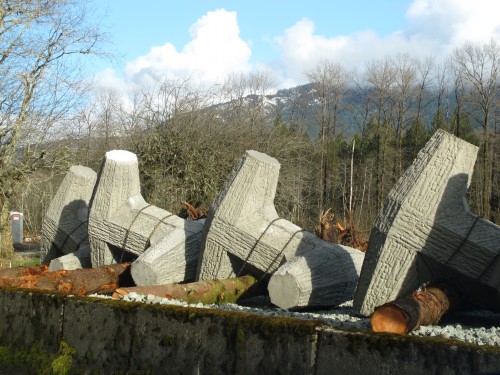
Whoa! Wha….?!
Sometimes one’s path is rerouted as they are traveling upon it.
Or so it can seem. It was early January, and we graduate students had recently returned to the Environmental Learning Center from a month away at various winter vacation destinations. We were crammed into a North Cascades Institute mini-van, traveling west on Highway 20 to our organization’s down valley headquarters at Sedro-Woolley. Suddenly, just east of Rockport near milepost 100, the road turned beneath our tires. Instead of rolling past the front of the Cascadian Farms stand at 45mph, we realized we were driving behind it. We checked to make sure we were still on the asphalt, hadn’t off-roaded into neatly planted rows of now leafless berry vines. The two Cascadian Farms structures with the whimsically sweeping roof lines were still there, but we had been re-routed for a different perspective. The whole carload of us did a double-take: Had we all collectively gone mad?
Nope. Rather, we were in the midst of a Washington State Department of Transportation (WSDOT) project to repair the Skagit River shoreline. Oh.
The “Skagit River Permanent Restoration Project” is a $10.2 million effort to attempt to permanently remediate the unstable river bank, an issue the state categorizes as a “Chronic Environmental Deficiency”. During five previous years – 1993, 1994, 2004, 2006 and 2007 – emergency rock buffers were installed temporarily as a quick fix. But WSDOT seeks a long-term solution to this problem of massive erosion, and they have a plan.
Using fir and hemlock logs, root wads and 20 foot-tall concrete blocks shaped like toy jacks called “dolos” (or “dolosse” plural, pronounced “dohl-awe-sah”), WSDOT is engineering four log jams along this stretch. The log jams are designed to protect the highway from the river’s erosive force, while the dolosse anchor them in place. Drive by slowly and glimpse the dolosse interwoven with the dead trees, intended to slow the mighty Skagit down. Better yet, canoe or kayak by for a perspective from the river.
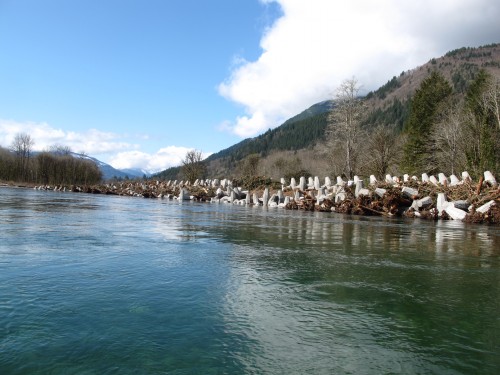 Approaching the project via canoe traveling downstream.
Approaching the project via canoe traveling downstream.
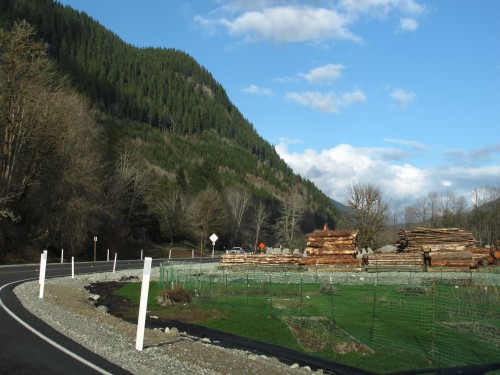 Taking the “back” road. Cascadian Farms’ property is temporarily transformed into a staging ground for the WSDOT project. Here, logs are stacked awaiting their important new role in the ecosystem.
Taking the “back” road. Cascadian Farms’ property is temporarily transformed into a staging ground for the WSDOT project. Here, logs are stacked awaiting their important new role in the ecosystem.
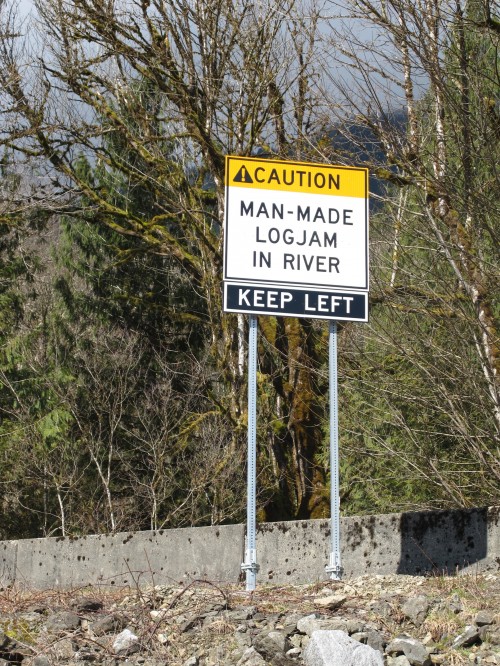 What’s happening.
What’s happening.
According to Project Engineer Shane Sphar, this is the largest engineered log jam/dolosse project ever constructed. In a description of the project from March 25, Sphar wrote, “Dolosse have a long history of use protecting marine shorelines from high-energy waves, but have not been used much in freshwater environments.”
In December 2013, WSDOT bypassed approximately 1,000 feet of Highway 20, re-routing the road around the back of Cascadian Farms from its normal placement in front of it. Active construction began on February 1. Work will cease after April as an attempt to work around tourist traffic, fish runs, bald eagles and increasing river levels. The restoration is scheduled to resume and be completed this fall.
Read the 141-page “Biological Opinion” report from 2011 by the U.S. Fish and Wildlife Service on the project here.
This is a plan to address a chronic problem. With the predicted effects of climate change, notably more rain-on-snow events, the shifting timing of seasonal runoff, and an increase in the severity and frequency of major flood events, could this project be the ultimate solution to riparian erosion along this piece of the Skagit?
Sphar writes that the log jam/dolosse combination will provide both a barrier against erosion and will also improve wildlife habitat. The emergency quick-fix of dumping big piles of large rocks against the banks in previous years negatively affected fish habitat, whereas log jams can increase habitat complexity and improve survival rates of juvenile salmon by providing food and shelter. So far, WSDOT said the project is ahead of schedule and under budget.
North Cascades National Park geologist John Riedel is not as optimistic.“It’s aesthetically jarring and I’m curious to see how it does or doesn’t work…I just see 50 or 100 years from now, big hunks of concrete cables, and then it will really need some restoration,” he said.
He emphasized that this stretch is part of the Skagit Wild and Scenic River System, which is managed, according the Mt. Baker-Snoqualmie National Forest, “to protect and enhance the free-flowing condition, water quality and outstanding values for which the river was designated, while providing for public recreation and resource uses that do not adversely impact or degrade those values.” Riedel wondered if the project is compatible with this designation.
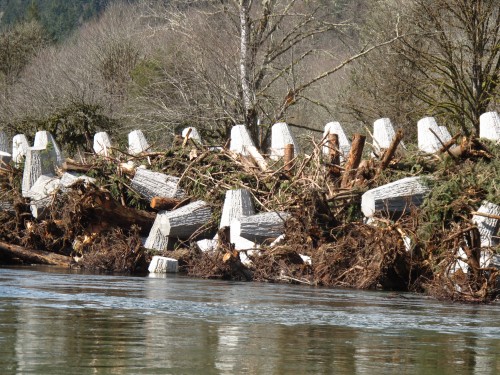 Riparian restoration using dolosse, logs and root wads. What will this look like in 10, 20, 75 years? Will it work?
Riparian restoration using dolosse, logs and root wads. What will this look like in 10, 20, 75 years? Will it work?
Part of problem contributing to the chronic vulnerability of the highway is the lack of native vegetation along the river bank, Riedel noted. There are no trees, shrubs and herbaceous plants to help hold the soil in place. Instead, the road is right there, nearly adjacent to the Skagit, and a bank capped with asphalt is much more vulnerable to being undercut by river erosion than one stabilized with vegetation would be.
“The river will be the ultimate arbiter on whether anything is permanent,” Riedel said. “None of these issues are ever simple.”
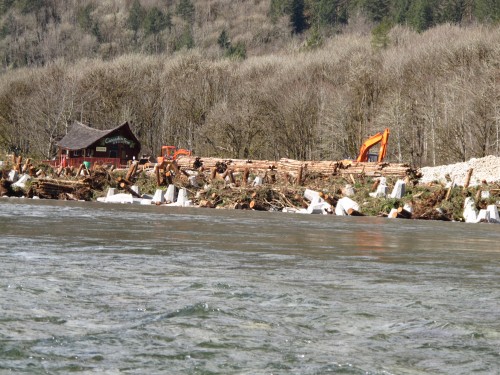 From the Skagit River. WSDOT’s “Skagit River Permanent Restoration Project” is a mega feat of engineering.
From the Skagit River. WSDOT’s “Skagit River Permanent Restoration Project” is a mega feat of engineering.
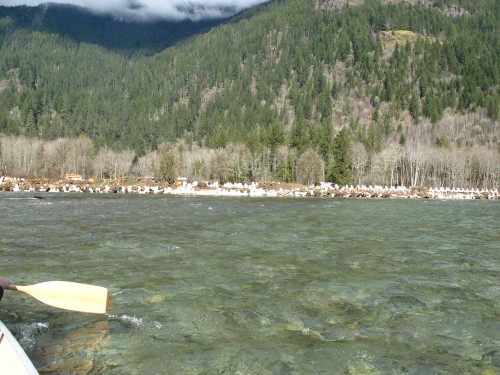 Hop in a canoe and check the project out from a river’s-eye view.
Hop in a canoe and check the project out from a river’s-eye view.
Leading photo: Dolosse and logs lined up like a game of jacks and pick-up sticks for giants.
All photos by author.
Katherine Renz is a graduate student in North Cascades Institute and Western Washington University’s M.Ed. program. She wonders what you think of this project? And what does “permanent” mean, anyway…..?


Katherine,
If this gets to you… I am curious how the project looks after 5 years. I am a hydrologist for the Forest Service in Idaho and I work on similar projects on the Idaho Panhandle National Forest. Thanks, Kevin